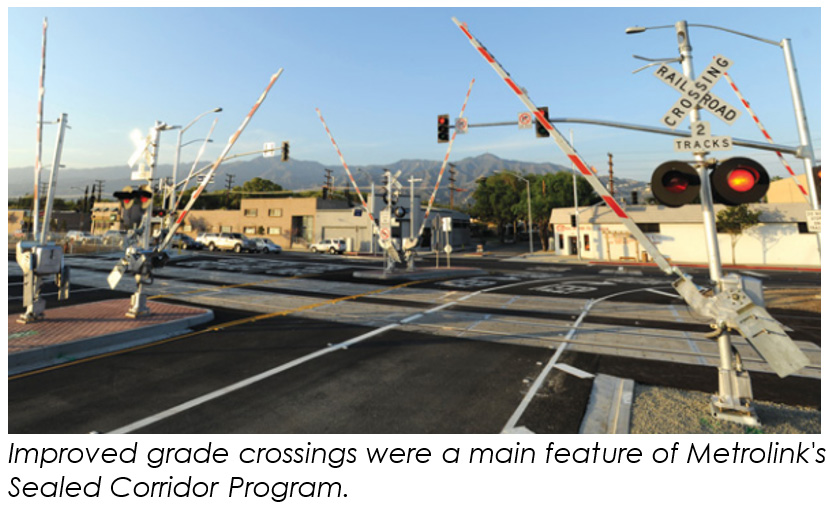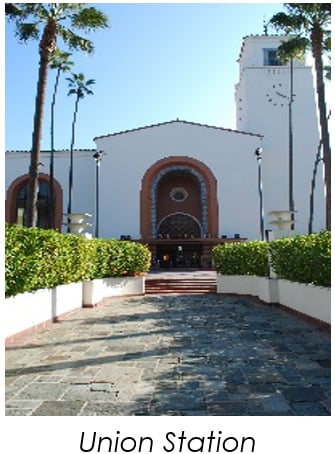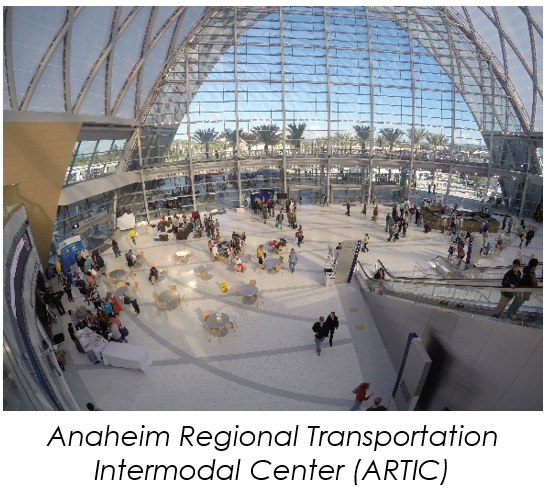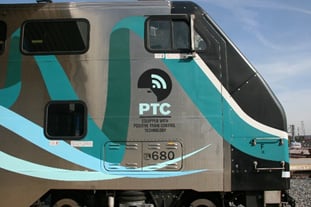HISTORY
Metrolink has been providing service to Southern California for 28 years. During this time, Metrolink has enhanced the quality of life by providing safe, efficient and reliable transportation service that offers an exceptional customer experience.
What began with three lines, 11 stations and 2,300 daily passengers, has now grown to seven lines, 62 stations, and passengers who travel approximately 406 million passenger miles per year.

1988 - 1992
How it all began
Riverside County residents approve Measure A, a 20-year half-cent sales tax to fund rail improvements and help transform public transit in Southern California.

San Bernardino County residents pass Measure I, a half-cent sales tax to ensure that needed transportation projects are implemented.
Leaders from Los Angeles, Ventura and San Bernardino counties purchase 173 miles of active and abandoned right-of-way from Southern Pacific Railroad.
Residents of Los Angeles and Orange counties approve half-cent sales taxes to promote needed rail improvements.
The Southern California Regional Rail Authority (SCRRA) is formed as a Joint Powers Authority (JPA), and chooses “Metrolink” as the official name for Southern California’s future commuter rail agency.
Metrolink purchases 366 miles of track from Atchison, Topeka and Santa Fe Railway (now known as BNSF Railway), and purchases 67 miles of track from Southern Pacific for what eventually becomes the Antelope Valley Line.

October 26, 1992
OPENING DAY
The first Metrolink service begins.
Metrolink offers three routes as alternatives to freeway congestion in busy transit corridors: The Ventura County Line, the San Bernardino Line, and the Santa Clarita Line, which will become the Antelope Valley Line.
Historic Union Station in downtown Los Angeles serves as Metrolink’s central transit hub.
1993 - 2004
Service expansion and growth
The Riverside Line opens to the public in June, becoming Metrolink’s fourth line in operation.
In October, Metrolink celebrates its one-millionth passenger.
On January 17, a major earthquake strikes Northridge. Severe impacts are felt throughout Southern California.
To meet the urgent needs of affected communities, Federal officials expedite construction of Metrolink’s Antelope Valley Line, and six stations are built in six weeks along its corridor and on the Ventura County Line, extending service to Lancaster and Oxnard.
The Orange County Line opens in March, becoming the longest in Metrolink’s system.
The San Bernardino Line’s Saturday Explorer debuts, pioneering the concept of regular weekend service, special trains and summer excursions, key customer incentives in the coming decades.
The Inland Empire – Orange County (IEOC) Line opens in October. It is the first suburb-to-suburb commuter rail line in the nation.
Metrolink’s first special Beach Trains make their debut on the IEOC Line.
Saturday Explorer service is added to the Antelope Valley Line. The popular Explorers gain steadily increasing ridership.
Metrolink's first Holiday Toy Express® train debuts in December, and collects more than 5,000 toys for underprivileged kids.
The Ventura County Transportation Commission approves the extension of six routes to Moorpark.
Metrolink experiences a boost in ridership resulting from Metro's Red Line extension to Hollywood. The region’s interconnectivity expands dramatically.
In October, a Simi Valley commuter becomes Metrolink’s 35 millionth rider.
Metrolink riders take advantage of a “First Month Free” promotion offered by Spectrumotion; the number of Metrolink commuters arriving at the Irvine Transportation Center increases 242%.
Metrolink works with government agencies to strengthen system security in response to the 9/11 attacks.
The 91 Line opens, becoming Metrolink’s seventh route and linking Riverside-Downtown, Fullerton and Downtown LA.
The Rail 2 Rail® program starts, allowing Metrolink Monthly Pass holders to transfer to selected Amtrak routes at no additional charge.
Metrolink’s 10th anniversary.
San Bernardino County voters overwhelmingly approve the extension of the Measure I sales tax for transportation improvements; 80.03% vote to extend the measure through 2040.
2005 - 2015
Tragedies inspire safety transformation
January 26: A Metrolink train collides with an abandoned SUV at an at-grade crossing in Glendale, causing 11 deaths.
Metrolink meets with legislators, regulators and federal lawmakers in Washington, D.C., to gain support for a comprehensive strategy of safer crossings, less accessible right-of-ways, and development of Crash Energy Management (CEM) rail cars, which incorporate state-of-the art collision-absorption technology based on findings by the Federal Railroad Administration (FRA).
In February, Metrolink’s Board of Directors awards Hyundai Rotem a contract to build 117 safety-enhanced railcars, the first in the U.S. to be equipped with Crash Energy Management (CEM) technology designed to absorb impact and reduce injuries in the event of a collision.

Metrolink initiates its Sealed Corridor Program to reduce the potential for accidents at 57 different at-grade crossings. A sealed corridor is an engineering design strategy intended to enhance the safe operations of trains by separating them from vehicles, motorists, and pedestrians along railroad rights-of-way.
Metrolink breaks ground on its Sealed Corridor Program to reduce the potential for accidents at 57 different at-grade crossings, and becomes the first U.S. commuter rail agency to apply sealed corridor methods to densely populated urban areas with high volumes of street and rail traffic.
A sealed corridor is an engineering design strategy that separates trains from vehicles, motorists, and pedestrians along railroad rights-of-way. Sealed corridor design features include four quadrant crossing gates, longer gate arms, Z-shaped pedestrian crossings, median separators on the streets, locked gates, and additional fencing work to restrict access to the right-of-way, with a goal of systematically reducing the opportunity for accidents.
September 12: A Metrolink train collides head-on with a Union Pacific freight train near Chatsworth, killing the engineer and 25 passengers.
This incident redoubles Metrolink’s commitment to safety. Metrolink strongly supports the Rail Safety and Improvement Act of 2008, requiring the implementation of Positive Train Control (PTC) by freight carriers and rail agencies by the end of 2015.
The act becomes law. Metrolink is determined to implement the life-saving technology to ensure the safety of its passengers, and sets a goal to implement PTC ahead of the federal mandate.
Metrolink expands its Sealed Corridor Program.
Metrolink becomes the nation’s only railroad agency, commuter or freight, to install inward-facing cameras in the operator’s cab of its trains to reduce the risk of accidents and provide additional safety for its passengers and crews. The cameras are used to verify train crews are in compliance with necessary operating and safety rules and procedures, for efficiency testing and systemwide performance review, and to deter unsafe or unauthorized crew member behavior while operating trains.
In August, Metrolink breaks ground on the Orange County Rail-Highway Grade Crossing Safety Enhancement Program. It is the largest grade crossing safety enhancement program in the United States, and includes 52 crossings in eight cities. The program uses the new design practices and standards for grade crossings, developed by Metrolink’s Engineering & Construction department.
Delivery of the first safety-enhanced Hyundai Rotem railcars equipped with Crash Energy Management (CEM) technology begins. Metrolink is the first commuter rail carrier in the nation to use the new CEM technology, which diverts energy away from passengers in the event of an incident.
The option to buy additional cars is approved by Metrolink’s Board, bringing the total to 137.

Metrolink's goal to implement Positive Train Control (PTC) ahead of the federal mandate receives a boost when it receives $46.3 million to support the installation of the new rail safety technology.
In July, Metrolink hosts a national rail safety summit in partnership with the USC Viterbi School of Engineering, uniting academic experts, rail system executives and government regulatory authorities.
Metrolink’s Board of Directors authorizes the agency to secure Tier 4 Locomotives. The diesel locomotives are the cleanest in the nation, and will reduce particulate matter and nitrogen oxide emissions by up to 85 percent, while using 8% percent less fuel. The engine offers significantly more horsepower, allowing Metrolink to move more people with more reliability. See the Tier 4 Locomotive Fact Sheet.
In September, Metrolink unveils its first fully-equipped Positive Train Control (PTC) test train. The National Transportation Safety Board (NTSB) recognizes Metrolink as a national leader in PTC: “Metrolink's leadership to implement PTC is a model for others across the rail industry to follow."
The Orange County Rail-Highway Grade Crossing Safety Enhancement Program is completed. Most of its $85 million cost is covered through taxpayer-funded Measure M, and is used to implement upgraded warning devices, additional gate arms, reconstructed crossing surfaces and medians, improved signage, and coordinated traffic signals. As a result of these safety enhancements, the OCTA member cities’ applications to establish Quiet Zones are granted by the Federal Railroad Administration (FRA). The approved Quiet Zone spans 34 railroad crossings in six cities and is the longest continuous Quiet Zone in the nation.
Metrolink’s 20th Anniversary Report is issued.
Metrolink receives the last of its new Hyundai Rotem railcars equipped with Crash Energy Management (CEM) technology.
Metrolink introduces TAP-enabled tickets and passes that are compatible with Metro’s TAP system, which reduces fare evasion while improving system safety and security. Over a one-month period, Metrolink riders tap more than 100,000 times at Metro turnstiles and validators.
Metrolink is on track to implement Positive Train Control (PTC).

In February, Metrolink achieves a milestone in Positive Train Control (PTC) when it receives authorization from the Federal Railroad Administration (FRA) and operates PTC in Revenue Service Demonstration (RSD) on the Orange County and 91 lines. RSD means trains in revenue service, or in Metrolink’s case, with passengers on board.
PTC involves a Global Positioning System (GPS) based technology capable of preventing train-to-train collisions, over-speed derailments, unauthorized incursion into work zones, and train movement through switches left in the wrong position. PTC monitors and, if necessary, controls train movement in the event of human error.
See the PTC Fact Sheet.
Metrolink receives critical funding commitments from South Coast Air Quality Management District (AQMD) to purchase its fleet of Tier 4 Locomotives.
Construction begins on the Perris Valley Line, a 24-mile extension of the 91 Line that is Metrolink’s first major expansion since the early 1990s.
![]()
![]()


75th Anniversary of L.A. Union Station.
The City of Anaheim opens the Anaheim Regional Transportation Intermodal Center (ARTIC), its 67,000 square-foot transportation and retail hub.
Oxnard Incident and Response
February 24: Thirty people are injured when a Metrolink train strikes an unoccupied truck and trailer near Oxnard. A valued member of the Metrolink team, an Amtrak engineer named Glenn Steele, later died from injuries from this accident.
As a safety measure, Metrolink leases 40 diesel locomotives from BNSF: a BNSF locomotive is positioned at the front of each train set, and a Metrolink locomotive is positioned at its end. Metrolink’s Board takes this temporary, proactive safety action out of an abundance of caution while the National Transportation Safety Board (NTSB) conducts its investigation.
Metrolink Achieves PTC Milestone
In June, Metrolink makes history when it launches Positive Train Control (PTC) in across the entire 341-mile network it owns.
Metrolink becomes the first railroad in the nation to have PTC running during regular service on all of its hosted lines, and remains on track to become the nation’s first passenger rail system to have a fully operational, interoperable, and certified PTC system in place by the federal deadline of December 31, 2015.
Across its 512 route-mile network, Metrolink also operates on track owned and dispatched by the Union Pacific Railroad, BNSF, and the North County Transit District (NCTD) in San Diego County. Metrolink, BNSF, Union Pacific, and NCTD, along with Amtrak trains, will all have to install and implement an interoperable system for PTC to be complete throughout the region.
See the PTC Fact Sheet.
Metrolink constructs safety improvements at four crossings in the Ventura County Sealed Corridor Project.
Burbank Bob Hope Airport opens its Regional Intermodal Transportation Center (RITC). The 515,000 square-foot facility establishes the first direct rail-to-terminal connection in Southern California.
2016 - PRESENT
Innovations and Beyond
March 2016
MOBILE TICKETING
Metrolink launches mobile ticketing for passengers making it easy to purchase tickets on the go.
June 2016
OPENING OF THE PERRIS VALLEY LINE
The opening of the Perris Valley Line, a 24-mile extension of the 91 Line that is Metrolink’s first major expansion since 1994, occurs on June 6. Four stations are constructed. Safety at 15 crossings is enhanced through the use of flashing warning devices, gates, raised center medians, striping and pavement markings. Pedestrian crosswalks are added at two crossings, while two other crossings are permanently closed for improved safety.
June 2016
METROLINK’S FIRST TIER 4 LOCOMOTIVE
Metrolink’s first Tier 4 locomotive arrives to Los Angeles Union Station.
The diesel locomotives are the cleanest in the nation and will reduce particulate matter and nitrogen dioxide emissions by up to 85 percent, while using 8% less fuel. The engine design offers significantly more horsepower, which will allow greater flexibility in scheduling service.
May 2017
SURFBOARD CARS
In partnership with Hurley, Metrolink launches redesigned Bike and Surfboard cars system-wide to encourage the surfing community and others to take public transit to Southern California beaches. Each Bike/Board car can accommodate up to five surfboards in netting carriers.
June 2017
$3.2 MILLION POSITIVE TRAIN CONTROL GRANT
Metrolink secures an additional $3.2 million in Positive Train Control Grant funding to improve system reliability, efficiency and security including the development of monitoring and troubleshooting tools, furthering its commitment to enhanced safety technology.
June 2017
INAUGURAL OC PROM TRAIN
On Saturday, June 10, more than 300 students from Los Amigos High School in Fountain Valley travel on a special Metrolink Prom Train from Santa Ana Station to Los Angeles Union Station to celebrate prom, the first time that Prom Train service is offered in Orange County. Prom Train service offers safe, reliable and memorable transportation for high school students while providing peace of mind to school officials and parents.
June 2017
FIRST CORPORATE PARTNER PROGRAM DISCOUNT
In anticipation of our 25th anniversary in October, Metrolink offers for the first time ever a 25% discount to new Corporate Partner Program members, good for six months after a partner joins the program.
September 2017
LAUNCH OF ONLINE TRAIN TRACKER USING GPS
Metrolink launches an updated website featuring a global positioning system (GPS) tracking tool allowing riders to locate trains in real time.
October 2017
NEW TIER 4 LOCOMOTIVES IN SERVICE
The first of 40 new clean fuel-powered Tier 4 locomotives begins service. Tier 4 trains reduce emissions by up to 85% and generate up to 64% more horsepower, improving reliability for passengers.
October 2017
25th ANNIVERSARY
On Friday, October 27, Metrolink marks a quarter century of transforming Southern California and bringing people together using fuel-efficient, environmentally friendly rail transportation. Riders joined regional officials in a unique ceremony focusing on the future of mobility in the region to celebrate this milestone.
December 2017
OPENING OF SAN BERNARDINO – DOWNTOWN STATION
Metrolink extends service on the San Bernardino and Inland Empire – Orange County lines with a new station in downtown San Bernardino, adjacent to the San Bernardino Transit Center, connecting riders to multiple regional transit agencies.
March 2018
LAUNCH OF METROLINK MATTERS BLOG
Metrolink launches a new official blog, Metrolink Matters, to provide the latest news and information to passengers and stakeholders in a user-friendly, easily-accessible digital platform that can be read on any computer or mobile device.
April 2018
$1.2 BILLION SCORE GRANT
A total of $1.2 billion in state grants is awarded to fund infrastructure and service improvements including Metrolink’s innovative SCORE plan. The Southern California Optimized Rail Expansion (SCORE) plan was developed in partnership with freight and intercity rail operators as a roadmap to increased rail service to accommodate expected population and job growth in advance of 2028, when Los Angeles will host the Olympics.
May 2018
APPLE PAY® NOW AVAILABLE
Apple Pay® is added as a payment method for the Metrolink mobile ticketing app, enabling customers to purchase tickets with just a tap.
November 2018
ONLINE TICKETING PORTAL TO PRINT TICKETS AT HOME
In another step to improve customer service and convenience, a Metrolink Ticket Web Portal is launched at https://tickets.metrolinktrains.com where one-way tickets can be purchased and printed at home.
January 2019
NEW CEO STEPHANIE WIGGINS JOINS METROLINK
Stephanie Wiggins, a transportation industry veteran with more than 24 years’ experience, begins her leadership as the new CEO of Metrolink with a strategic vision of enhancing the customer experience for current and future riders.
February 2019
LIFESAVING AEDS INSTALLED ON ALL TRAINS
Automated External Defibrillators (AEDs) are installed on all trains with hands-on and online instruction in use of the life-saving technology.
September 2019
NATIONAL RAIL SAFETY SUMMIT FEATURING LEADERS IN NEW TECHNOLOGIES
Metrolink hosts a national Rail Safety Summit welcoming leaders in safety and security from around the country. Issues addressed include railroad crossing safety, mental health and homelessness affecting rail safety, quiet zone implementation and future improvements to Positive Train Control (PTC).
September 2019
CEO TESTIFIES BEFORE CONGRESS FOR SUPPORT
Metrolink CEO Stephanie Wiggins testified before the House of Representatives on the challenges and opportunities faced by commuter railroads like Metrolink to ask for the support we need to serve the region.

